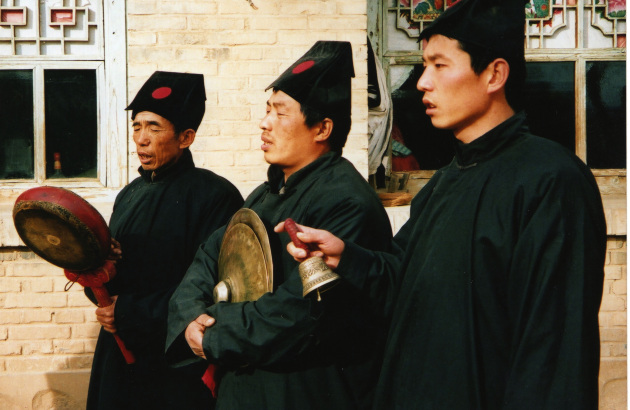小编按:作为一位长期关注中国音乐文化研究尤其是陕北地区音乐文化研究的外国学者而言,钟思第先生常常被学者们称为“闹钟”——他经常关注到研究中容易被中国本土学者所忽视之处。而在本文里,他又一次显露出这一特点。在文中,他立足于田野的基础上,进一步思考道教正一派与全真派两个分支的“虚拟的二分关系”。他提出名义上的派属、仪式参照文本(科仪本)与实际的仪式实践与表演之间的差距问题。而在某些地方也存在民间参照“国家权威寺庙”的仪式元素来改革地方仪式的现象。此外,他也对学界存在的对民间道教音乐与道观内传承的“正统”道教音乐做出固化的风格判断问题提出了反思。
Rethinking Zhengyi and Quanzhen: an update
Posted on 08/07/2017 by StephenJones.blog
I’ve just added to my page on Rethinking Zhengyi and Quanzhen, but it’s worth highlighting my new reflections here.
I began exploring the false dichotomy between Orthodox Unity (Zhengyi) and Complete Perfection (Quanzhen) branches in my book In search of the folk Daoists of north China (note especially pp.17–18). Now that we have more instances, let’s revisit the scene.
In areas of north China for which I have information (see In search of the folk Daoists of north China), household Daoists may nominally belong to either Orthodox Unity or Complete Perfection branches. But such simplistic pigeonholing may distract us from the details of their ritual practice.
In their rituals and ritual manuals I can discern no significant distinction. When the Complete Perfection branch evolved in the 12th century, its priests (both temple and household) took over Orthodox Unity ritual practice: as John Lagerwey once observed to me, “that was the only show in town”. And while a distinct Complete Perfection literature did evolve (see my book, pp.203–207), their ritual practice never developed into a separate corpus of Complete Perfection ritual texts.
That explains why such an august Complete Perfection temple priest as Min Zhiting (see above) was constantly citing Orthodox Unity ritual manuals from the Daoist Canon; and why the best mainstream source for the manuals of the Orthodox Unity Li family household priests in Yanggao is the repertoire of modern “Complete Perfection” temple practice like the Xuanmen risong.
On the evidence to hand, household Complete Perfection Daoists seem rather more likely to recall their place in their particular lineage poem. They may have a clearer family tradition of earlier ancestors having spent time as temple priests. But household Orthodox Unity priests may also possess both these features. Of course the histories of such groups need documenting, but when we come to performance (which, after all, is the heart of ritual) it may be less germane.
And in some places now—since around 2000—the picture is further confused by a certain “centripetal” tendency. With wider access (such as the internet), some groups that have always been Orthodox Unity may be exploring ways of “legitimizing” themselves by seeking manuals from prestigious central sites like the White Cloud Temple in Beijing, and having costumes and hats made which make them appear to be Complete Perfection Daoists. They may even reform their “local” ritual practice by adopting elements from the “national” White Cloud Temple.
The scene is further obfuscated by a tendency among some scholars (both local and central) to assume that if a group is household-based, then they must be Orthodox Unity—a problem I have already queried. We really must debunk this assumption. In my recent posts, the Changwu Daoists turn out to belong to the Huashan branch of Complete Perfection, and the Guangling Daoists appear to come from a Longmen tradition. Actually, this is not so clear-cut—even non-Quanzhen priests might adopt Longmen titles (note sources by Vincent Goossaert cited in my In search of the folk Daoists of north China, p.18 n.34).
So while the ritual texts and ritual sequences of the two notional branches are rather similar, what always makes local traditions distinctive is the way in which the texts are performed.

Vocal trio, 2001: Li Manshan, Golden Noble, Li Bin.
Even here there’s another erroneous cliché that needs debunking. Generations of scholars of Daoist music have parroted the notion that in style the “music” of Orthodox Unity (conceived narrowly as “household” or folk) Daoists is more popular and lively, whereas that of Complete Perfection (again, conceived narrowly as austere monastic) Daoists is solemn, slow and restrained. It derives entirely from an unfounded theory about household and temple practice. We only need to watch my film about the Li family band to realize this simply won’t do. Orthodox Unity Daoists, their basic style (exemplified by the zantan hymns that permeate all their rituals) is extremely slow and solemn—but as you can hear, it is indeed punctuated by exhilarating moments. The style of (household!) Complete Perfection Daoists is certainly no more “solemn”. Both branches may use melodic shengguan instrumental ensemble—and if anything, that of the Orthodox Unity groups tends to be more slow and solemn.
Indeed, when I showed Li Manshan my videos of funeral segments by the Complete Perfection Daoists in Shuozhou, he found their performance “chaotic” (luan). Orthodox Unity groups in Yanggao like that of Li Manshan pride themselves on the “order” (guiju) of their performance.
My only ongoing note on this is that several household Complete Perfection groups (such as in Shuozhou and Guangling) may have preserved the element of fast tutti a cappella recitation of the jing scriptures better than in some Orthodox Unity traditions like those of Yanggao. But that doesn’t bear on the false stylistic dichotomy. Like Life, It’s Complicated… We always need to expand our database and use our critical faculties.


